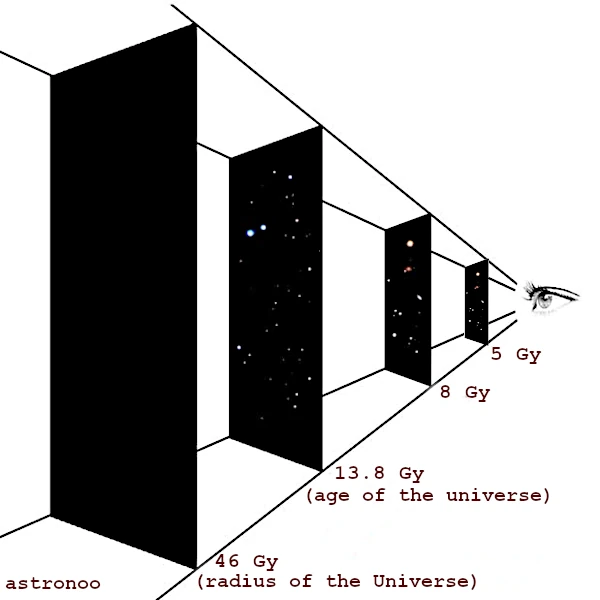
The observable Universe has a radius of about 46 billion light-years, a value that seems paradoxical given that the age of the Universe is estimated at 13.8 billion years. This paradox is explained by the expansion of the Universe: space itself is stretching, allowing light to travel greater distances than the simple product of the speed of light and the age of the Universe.
The expansion of the Universe means that space itself is growing over time. It is not that galaxies "travel" through space like rockets, but rather that the space between them stretches, somewhat like points drawn on the surface of an inflating balloon.
This idea was confirmed by Edwin Hubble in 1929, who observed that the farther a galaxy is, the faster it moves away from us. This is summarized by the simple formula: \(v = H \times d\), where \(v\) is the recessional velocity, \(d\) is the distance, and \(H\) is the Hubble constant.
Due to this expansion, the observable Universe is much larger than its age expressed in light-years: although it is 13.8 billion years old, its observable radius reaches about 46 billion light-years. The light from distant galaxies has traveled all this time, but space has stretched during its journey.
N.B.:
Recent discoveries even show that this expansion is accelerating, as if a mysterious "dark energy" is pushing the Universe to grow faster and faster.
The distance measured at a given cosmological moment is called comoving distance, i.e., by "freezing" the expansion at a given moment. This is the definition used today to express the observable radius of 13.8 billion years.
However, the comoving radius corresponds to a distance measurement that remains fixed for a given object, regardless of the expansion of the Universe. For example, a galaxy whose light takes 13.8 billion years to reach us is currently about 46 billion light-years away in comoving distance. This quantity is essential for comparing cosmological scales, as it neutralizes the effect of expansion and clearly defines the volume of the observable Universe.
N.B.:
The value "46.5 Gly" refers to a comoving distance today, not the travel time of light; the difference comes from the expansion of space.
Beyond this horizon of 46 billion light-years, there is a part of the Universe that we cannot observe. The light from these regions has not yet had time to reach us since the Big Bang. According to standard cosmological models, the Universe could be either infinite or finite but without a boundary.
To understand the observable Universe, several notions of distance and time must be distinguished. Together, these concepts help to better visualize the structure and evolution of the observable Universe.
| Concept | Definition | Indicative Value | Comment |
|---|---|---|---|
| Observable comoving radius | Comoving distance today to the surface of last scattering | ≈ 46.5 Gly | Model-dependent value, commonly cited as "46 billion light-years". |
| Observable diameter | Twice the comoving radius | ≈ 93 Gly | Observed comoving volume associated with the sphere centered on the observer. |
| Hubble radius | \(c/H_0\), characteristic scale | ≈ 14.4 Gly | Scale related to the value of \(H_0\); different physical meaning from the particle horizon. |
| Age of the Universe | Time elapsed since the Big Bang | ≈ 13.8 Gyr | Well-constrained parameter by the CMB and cosmological data synthesis. |
According to Einstein's special relativity, nothing can travel faster than light in a vacuum. This speed limit, \(c \approx 299,792\) km/s, is fundamental to causality and the very structure of spacetime. Thus, a spaceship or particle can never reach or exceed this speed by moving locally through space.
However, there are exceptions on a cosmological scale. The expansion of the Universe can separate two objects at an apparent speed greater than that of light, without violating relativity. Indeed, it is not the object that moves through space faster than \(c\), but space itself that stretches between them. This explains why very distant galaxies appear to be moving away from us faster than light, within the standard \(\Lambda\)-CDM model.